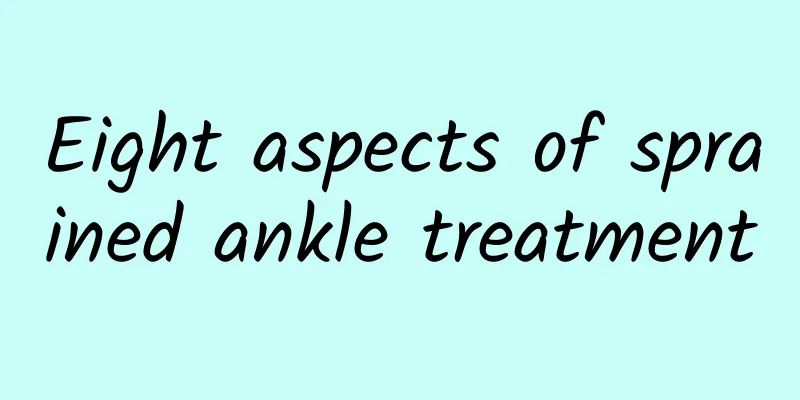Eight aspects of sprained ankle treatment

|
In our daily life, accidents of one kind or another may happen sometimes, such as some trauma. When we play ball or walk, we may experience symptoms of sprained ankle. Sprained ankle is professionally called ankle sprain. The reason is that the range of motion of our ankles is limited, but external injuries cause the ankles to exceed the range of motion, which causes the ligaments around the joints to be pulled, injuring the ankles, restricting our movements and causing physical harm. So what exactly is the reason for sprained ankles? If we sprain our ankles during exercise and activities, what should we do scientifically? We know that if the injury is serious, we must choose to go to the hospital for treatment. So when we are diagnosed with sprained ankles, what methods can we take care of ourselves early? Prerequisites: To talk about what to do if you sprain your ankle, you have to first talk about what sprains happen to. Spraining an ankle is something that people often encounter in life. The official medical name is "ankle sprain." This type of injury occurs when the foot and ankle exceed their maximum allowable range of motion, usually due to excessive external force. The muscles, ligaments and even joint capsules around the joint are pulled or even torn, causing people to feel pain and swelling, and walk with a limp. When you sprain your ankle, the injured part is usually on the outside of the ankle. Because the inversion angle of the human ankle joint is much larger than the eversion angle, sprains basically twist the ankle inward. A sprained ankle can cause local small blood vessels to rupture and bleed, which together with the exuded tissue fluid will form a hematoma, which usually takes about 24 hours to repair. What to do if you sprain your ankle? 1. Distinguish the severity of a sprained ankle. The main purpose is to determine whether a fracture occurs. If the bone is fine and only the ligament is sprained, you can apply cold compress and go home to rest as soon as possible. However, if it is a fracture, you must seek medical attention as soon as possible to avoid missing the best time for treatment. The method to distinguish the severity of the injury is as follows: "If there is no severe pain when you move your ankle, and you can still stand and walk with ease; if the pain is not in the bones but in the muscles, it is mostly a sprain and you can treat it yourself. If you feel severe pain when you move your ankle, cannot stand or move with ease, the pain is in the bones, or you feel a sound inside the foot when it is sprained, and swelling appears quickly after the injury, especially the tenderness point is on the outer ankle or the protruding bone in the middle of the outer foot, then it is a sign of a serious injury." 2. Apply cold compress quickly. There is nothing much to say about applying cold compress if you sprain your ankle. As long as the injury is not serious such as a fracture, the first thing to do is apply cold compress. There are many ways to apply cold compress in an emergency. Ice is the best, but what if you are at a sports field and there are no ice cubes? It is easy to buy popsicles in the summer. If that doesn't work, use iced mineral water or something like that. At the very least, rinse with cold water. Cold compress should be applied as soon as possible within 30 minutes after spraining your ankle and should not last less than 20 minutes (these are all my personal experiences, and the doctor is very satisfied with my approach). Cold compress can greatly reduce the swelling caused by broken capillaries after spraining your ankle. 3. Go to hospital for treatment. If it is not very serious, you can handle it yourself. If you are worried, go to the hospital and take an X-ray. It will be clear at a glance whether there is any problem, and you will feel at ease. Although sprains happen frequently, we should not take them lightly. Sometimes, if a sprain is serious, although it will not lead to a fracture, it may cause serious ligament damage or bone fracture. 4. Reduce activity within 24 hours, elevate the injured foot, and continue to apply cold compresses. Until the bleeding stops. The principle basis for judgment is 24 hours after the injury, and the following points can also be used as reference: first, the pain and swelling tend to stabilize and no longer continue to worsen; second, the feeling of swelling when raising and lowering the affected foot is not much different; third, the temperature of the skin at the injured area changes from being slightly higher than the normal part to being quite similar. These can all be used as a basis for stopping bleeding. 5. Generally, the swelling will ease 24 hours after spraining your ankle and will not continue to expand. At this time, you can use hot compresses or some blood-activating and blood-stasis-removing plasters, sprays or ointments to cooperate with the treatment. Do appropriate activity, but avoid strenuous activity or activity that causes severe pain. Wait until the injury gradually improves before increasing the amount of activity. Generally, there will be improvement within 3 to 4 days. 6. Massage correctly. Before the bleeding stops, it is advisable to continuously massage the hematoma. The method is to press the local area with the thenar eminence of the palm. The pressure should be tolerable even though it is painful. The time is to press continuously for 2 to 3 minutes and then slowly release it, pause for a moment and repeat the operation. Each repetition is 5 times as a stage, and it is appropriate to do 3 to 4 stages a day. After the bleeding stops, knead the area, using the thenar eminence or the tip of your thumb to apply a certain amount of pressure and knead the area. The direction is centered on the obvious swelling, and knead in all directions around it centrifugally. Do it for 2 to 3 minutes each time, and do it 3 to 5 times a day. 7. Use medication rationally. Before the local swelling caused by the sprain stops, do not use oral or external blood-activating drugs. You can use the "Get Better Fast" spray. After the bleeding and swelling stop, it is advisable to apply Wuhudan externally and take Dieda Pills, Huoxue Zhitong Powder internally. In the later stage, Chinese herbal medicine can be used for fumigation. If you don't have any Chinese patent medicine on hand, you can also fry the flour until it turns yellow, mix it with rice vinegar and apply it to the affected area to replace the Wuhu Dan, and the effect is also ideal. Boil water with a small pinch of Sichuan peppercorns and a handful of salt for fumigation and washing, which is also a good alternative to Chinese herbal medicine. Of the medicines I found on the Internet, I have only used the "quick cure" ones, so it's best for you to ask your doctor. 8. What should I eat if I sprain my ankle? I checked online and found that if I have edema after spraining my ankle, it is okay to eat more pig's trotters. Also, nuts, meat skin, poultry and fish will do. If you often sprain your ankle, it is very likely that you are lacking calcium. As for calcium supplements, I won’t go into details here. The above article introduces eight aspects of how we should deal with sprained ankles. As long as we know how to diagnose the severity of the condition first, use rapid cold compress methods, know how to massage correctly, use medications reasonably, reduce activities, and then go to the hospital for treatment in time, we can supplement more calcium in the later stage. I believe we will be able to deal with sprained ankles properly. |
<<: What kind of disease is tuberculosis?
>>: Three ways to treat snoring
Recommend
What are the symptoms of pulmonary edema?
Pulmonary effusion is not a single disease, but a...
What to do if your nose is blocked by rhinitis
We often encounter nasal congestion in our lives....
What causes dark lines on nails?
Normal people's nails look very smooth and be...
The role of acupuncture slimming patch
There are so many ways to lose weight, including ...
Chinese medicine formula for anxiety
Anxiety disorder is a condition that many people ...
What is the disease of white foam in the stomach?
Gastric disease is the most common disease in lif...
Women's appetite suddenly increases?
As people's health awareness improves, many p...
What is the reason for not ovulating during ovulation period? What should I do if I don’t ovulate during my ovulation period?
Many women want to have a baby, but they never ov...
The Taoist secret that has not been passed down for thousands of years - tapping the eight voids
Liver evil gathers in the armpits, heart and lung...
The efficacy and function of northern wind
When seeing the name Fangfeng, everyone must thin...
How to quickly solve stomach burning and acid reflux
Acid reflux and heartburn are common symptoms in ...
What causes Evans syndrome?
There are more and more various diseases, some ar...
Interesting recipe song of Nine-flavor Qianghuo Decoction
Qianghuo cinnamon powder soup is actually made by...
Are masses and tumors the same?
Most people often associate lump and tumor, and e...
Why does it hurt when you press your eyebrows?
Everyone has emotions, especially when under grea...









